
|
In which I visit Mykonos, Kos, Rhodes,
Crete, Nafplion and Athens, return from Greece via Italy and start my
third year at Reading University
Saturday 1 September 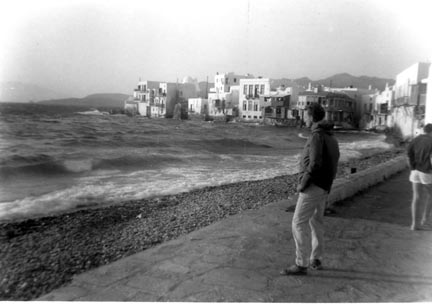 Sunday 2 September We arrived at Kos at 06.00. The small boats are better than those of Mykonos. Very pleased to see a notice on the quay which reads: "Welcome to our island". A Greek man came on to the quay and asked us if we wanted a room, we eventually decided to have a look and accepted at 15 drachma per night. It was in the private house of a widow. Very clean. She went into the room which was to be our bedroom and there was a cluttering about. Shortly afterwards her two daughters came out rubbing their eyes. She had evidently woken them up and turned them out so we could have their room. We went out early to have a sandwich breakfast and took a photo of some kids on the beach. Came back toards the port of Kos to have a look around (1 ouzo and two lemonades 3 drachma!) It is a wonderful place. There doesn't seem to be a shortage of water in the main town. We could see the coast of turkey from the beach. The roads are lined with palm trees and magnolia bushes (which are just past their prime), which, against the whitewashed houses have a wonderful effect. There is a great contrast with Mykonos which is virtually treeless. There are some ruins but we didn't explore them because of the heat. There are a large number of bikes, the local boys go around on mopeds instead of motor bikes. There are no coaches or buses on the island. Went to a taverna to get some food this evening. We went into the kitchen and pointed to three things and were given three plates each instead of one plate each. We also had a bottle of retsina. It was a formidable task which I failed to complete. The bill came to 15 drachma each. Walked around the town afterwards to try and walk dinner down. 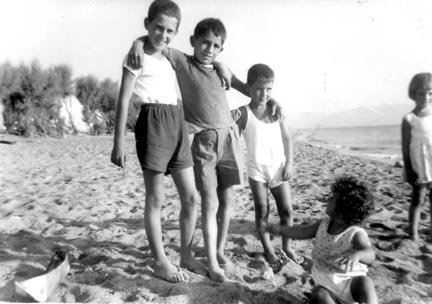 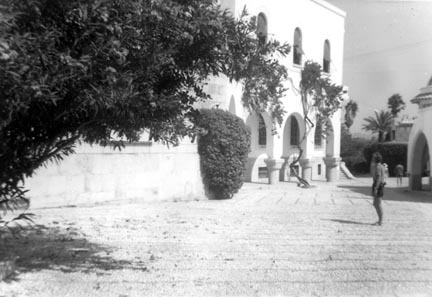  Last night's meal certainly had its effects - I was sick in the night and my stomach has been upset all day. Haven't done much all day. We set out for a walk in the afternoon but I soon gave up with my stomach. I didn't have anything to eat until after midday. We went back to the house where we stayed until about 18.00, collected our rucsacks, paid and said goodbye. The elder daughter was the only one who spoke English (we only came across two others on the whole island). I've no idea how old she was, probaby about 14-15 but she had a very nice figure and was very pretty. Most of the time she wore a smock which made her look pregnant. She wore a jumper and skirt just before we left - I don't know if it was for our benefit or not! We had to catch the "Marilena" at 03.30 so we decided to sleep on the beach and take it in turns to stay awake so that we wouldn't oversleep. Tuesday 4 September Slept pretty well but managed to catch the "Marilena" alright. On the way to Rhodes (arr. 08.30) we passed within about 100 yards of Turkey. We had great difficulty in finding the youth hostel. We were directed to the address given in the handbook but this place has since been condemned. We eventually found the hostel after 1½ hours. It is a new one built in the gymnasium. We had a late breakfast of bread, butter, honey and milk at a restaurant on the harbour front. We then went to a beach where we had several swims and did some sun bathing. Came back through the town but my stomach began to play up again so I came back to the hostel. Later on, we went out for a meal of egg, chips and salad. Went to bed early. Wednesday 5 September Went down to breakfast on the front with two Israelis from the hostel. We decided to go to the springs at Kalithea. It wasn't very far so we decided to walk but managed to hitch for about two miles on the way there and managed to get a lift all the way back. Although the springs are very pleasant we were, on the whole, rather disappointed with them. The spa is very close to an inlet of the sea which is pleasantly cool and wonderfully clear. Had a good swim. We drank the waters which tasted rather salty - nothing special really. Having been rather burnt yesterday I kept well out of the sun, it doesn't hurt but will probably if it gets a great deal more in the next day or so. Back at Rhodes we had a look at the old fortress and lighthouse at the end of the jetty which originally supported one of the legs of the Colossus of Rhodes. The fortress was built by the Knights of St. John between 1300 and 1500 AD and it is built very substantially. We came back to have a meal and then had a look around the older part of the town which is completely enclosed by the old town walls. This part has many narrow streets, all of whch are cobbled. There are many shops, a large proportion of which cater to the tourist trade, in particular the hand made silverware for which Rhodes is famous. There is some wonderful work and some is reasonably priced although some is extremely expensive. We saw a miniature model of the Parthenon in gold complete in every way, for a bracelet: price 1,000 drachma! Bob and I both bought a couple of brooches. Most of the brooches are silver with a gold-plated motif in the centre. I have also bought a red velvet Greek hat complete with gold braid and tassel. We went to over a dozen shops and eventually paid 35 drachma - some places were asking 50 drachma and the regular price on Mykonos was 60 drachma. I'm quite pleased with myself. Thursday 6 September We took the bus from Rhodes to Lindos this morning, leaving at 08.30. I should think that the drivers have their regular coaches because of all the photos that are stuck above the driver around the clock - pictures of his family, his coach, his pinup and his racing hero. An Austrian from the hostel was also going and we palled up for the day. The trip was quite interesting both in the type of country and the people. In some places the country is very impressive as we had to cross a couple of off shoots from the island's central mountain chain. This proved the most exciting if not the most nerve racking part of the journey. There were a large number of hairpin bends which had to be negotiated with care. An old bus behind us kept hooting at us all the way up, presumably wanting to get past - we soon lost him on the other side. In the lower areas there is a large amount of farming carried out with the aid of irrigation. I noticed that the women do most of the work leaving men to sit in the cafes - sitting and talking or just sitting. We stopped for ten minutes at the monastery of Mont Tsambikas. There were two buses parked and an old widow had an argument with the two conductors as to which bus was the right one. Eventually, one conductor picked her up and carried her bodily to the right bus. She was still muttering to hersef as she found a seat. 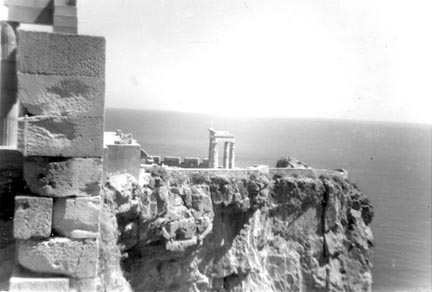 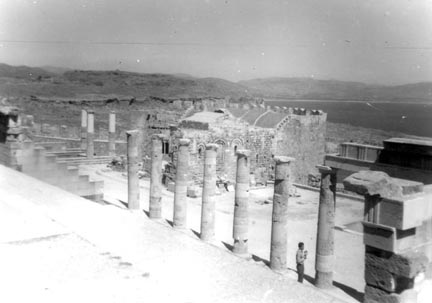 Lindos We passed through a small village where a group of men and women were sitting at a large table listening to the priest. He stood up and everyone else did while he walked to the side of the street and spat in the gutter. He went back and sat down - then everybody else sat down. Friday 7 September We decided to go for a walk along the other coast road today. We didn't get very far, just as far as Ichos. We had a swim close to Rhodes, very pleasant though not as warm as at Lindos or Kalithea. We had dinneron the beach at Ichos and I went to sleep for over an hour. We walked back along the same road and stopped off to visit Mount Smith. We didn't actually find it but we walked a good 800 metres as it said on the sign post. We had an early dinner at the same cafe close to the hostel and then wandered around the town. I bought a special sandwich which was only 2.50 drachma, the other was 3.00 drachma. It certainly wasn't in the English tradition. Its a kind of pancake rolled up with meat, onions, sauce and flavouring in the centre. Very good but slightly indigestible if too many are eaten. Bob has also bought a Greek hat, a blue one. we met that Greek woman again but managed to get rid of her. There is a cafe just up the road from the hostel which has a band and singers complete with loudspeakers. Eastern-type music blares out every night until about 02.00. We heard them warming up this evening with "Roll out the barrel". It didn't sound quit right somehow, but even so it provided a great deal of amusement. Went to bed quite early - both tired out. Saturday 8 September This is our last day on Rhodes. Had the usual breakfast and then went to find out what time our ship would leave for Crete. As usual, nobody knew. Had a look at the museum. There is a very fine hall which has been reconstructed, the wooden roof is particularly good. This gave us a good idea of the atmosphere of the place in former times. There were several carvings with seven castles and some more had five castles. Saw a locust (cicada?) on a leaf in the garden - it didn't want to have its photo taken. There are also some fine statues, statuettes, sarcophagi and pots of various ages (including 3 pots dating from 2000 BC) and a couple of rather poor mosaics. I was disappointed that there wasn't any Samian pottery on show. The island of Samos is quite close and I expected a little of its famous Roman era pottery. Later on we found some shade and had some food after which we had a swim and did some sun bathing. We eventually found out that the boat was due at 20.00 so we went back to the hostel and collected our rucsacks. Had the normal dinner at the same cafe. Bob took a photo of the proprietor and his friend with the cap who always seemed to be in there drinking ouzo. He had a strange clientel what with the woman with the glass eye and the deaf and dumb man who had lost his tongue fighting in the war. We never did find out who he fought for - he seemed quite friendly to us, however. I bought two sponges on the way down to the jetty. The ship, the Epiros, was about 2½ hours late and we didn't embark until nearly 22.30. There was a great deal of room and we didn't have any trouble finding a bit of deck to sleep on. Sunday 9 September I had a good night on the deck of the "Epiros" although there was some moisture on the deck and sleeping bag but this soon dried out in the sun. The "Epiros" is rather different from the rest of the ships we have been on. It is more of a cargo ship and is painted black instead of the white of the others. The sea was very calm. We arrived at Heraclion (Crete) at midday (4½ hours late) We walked up the main street to the Tourist Police who found us a room with two German students at the Arcadi Hotel for 20 drachma a night. Had an opportunity to walk around the town which is terrible - virtually a shanty town. Besides this, the people are not very friendly as we keep on being mistaken for Germans who gave the people arough time during the war. We were spat on in the street. We have therefore resolved to leave Crete sooner than expected, probably on Tuesday. Monday 10 September 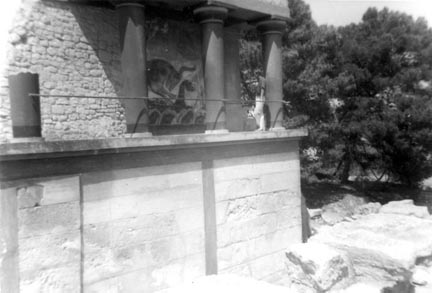 Tuesday 11 September We booked our tickets for the "Polikos" back to Piraeus this evening and then went to the Archaeological Museum in Heraclion. It is well laid out, there is a setroute around. very interesting although a bit tiring. We found some of the tabets containing the Knosson palace accounts which were written in Linear B, Walked around the town walls, not very pleasant. we boarded the "Polikos" at 17.45 (due out 19.00) and only just found room on the top deck to unroll our sleeping bags among the English and German students. We left Heraclion at 19.10 and were very pleased to leave. The sea was quite rough and at one time I thought I was going to be sick. I didn't sleep too well. It was a good job we were on deck as the cabin was hot, stuffy and stank of vomit. Wednesday 12 September We arrived at Piraeus at 07.10, caught the Underground to Omonia and walked to the hostel which is close to the University. We walked around Athens, collected mail from Cooks and booked our ticket for the journey to Nafplion tomorrow. Have had a good look around the back streets of Athens which are very interesting. Thursday 13 September We took the narrow gauge railway to Nafpion today (my first narrow gauge train ride other than in Wales). The diesel was due out at 09.35 and left right on time. It was very comfortable with soft seats that could be individually adjusted. The narrow gauge (1 metre) is not really noticeable because the coaches are virtually standard gauge width. The most noticeable difference is the speed which is much lower. We passed over the Corinth Canal just before Corinth, a straight slit in the sandstone, very impressive. There were four narrow gauge steam engines at Corinth which included two tender engines, all very clean. We changed for Nafplion at Argos. The two coaches and two vans, one at either end, were hauled by a 2-6-0 tank engine. The carriages, which were painted blue and lined in cream seemed quite modern but were of the wild west type with verandas at each end. We could just imagine a running cowboy fight taking place on the roof. The whole journey was accompanied by much use of the very high-pitched whistle. Bob called it an overgrown chicken which seems a little unfair. We found the hostel after a little trouble. It seems very good, the only trouble is that all the tap water is salt. We went for a walk around later on in the afternoon and found the beach which, for the most part, is just a rock slab, a bit uncomfortable if you're not careful. We met up with two girls from Reading. Everyone else was drinking retsina and became slewed. I don't like it and stayed sober. Friday 14 September Went down to the same restaurant for breakfast with Judy and Pat. Usual breakfast with hot bread. Afterwards we climbed up to the old fortress on the top of the hill overlooking the town. In all, we went up more than one thousand steps. We had a good view over the town and sea with swarms of jelly fish. The fortress is very interesting - a pretty good defensive position even though there is a road entrance on the other side. We came down for a swim and then went back to the hostel for a siesta. At about 17.00 we went to the coast to take a photo of the fortress and then climbed up again to get a view of the sunset which is a famous view. After a late dinner we said goodbye to Judy and Pat and went for a short walk around the town. Saturday 15 September We had breakfast at the usual restaurant and decided to walk below the cliffs to Tolon which is about 8 kilometres to the south-east of Nafplion. We passed the market which seems to be for small growers and producers only. It is held in the open space outside the railway station, among piles of earth which will eventually become a flat pavement. It is a country market in the sense that English markets were in the past. We saw one boy who had brought in a couple of dozen eggs and a few kilos of tomatoes - that was all he had brought. We tried to get along the cliff path to Tolon but it became narrower and narrower until we reached an abrupt end against a sheer rock face with the sea below. We sat around for a little while - the weather wasn't so warm. It was petty cloudy whch kept things cooler. We spent some time bombing jelly fish, there are swarms of them in the sea, most about 12 inches across. Went for a walk in the afternoon, it turned out to be past the prison. We learned about the prickly pear's prickles - the hard way. Saw a small whirlwind (twister) which passed over Tirens. It didn't do much damage. Sunday 16 September 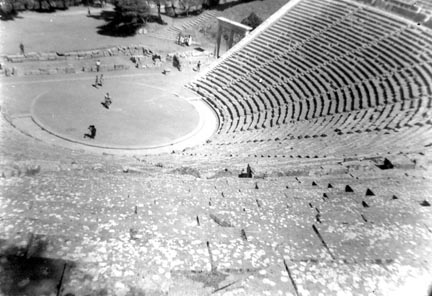 Epidavros Monday 17 September My stomach is back to normal today. I had an earlier than normal breakfast and went down to the station to get our tickets for the trip back to Athens tomorrow. Not as much trouble as I had expected and I even bought some tickets as souvenirs. I caught the 09.50 "Flyer" to Argos. D8
- Nafplion branch train at Nafplion.
The trackwork is flatbottom rail
screwed to sleepers directly with a metal plate in between the sleeper
and the rail. The Nafplion branch engine, No. Z547, is a 2-6-0
tank engine painted black and lined out in red. The side tanks extend
right up to the smokebox. Walschaerts valve gear is fitted.
There is a pipe secured to the chimney which is tall and has a wire
netting spark arrester. The braking system seems to be automatic
vacuum and not Westinghouse - I could neither hear nor see a
Westinghouse brake pump. There are two brake connecting pipes at
the end of each vehicle. Centre buffers and couplings are fitted
with two side chains. I nearly had a fit when I saw them coupling
up to the engine. First the shunter ran across in front of the
buffer and then he tried to throw over the hook with his foot on the
rail about one foot from the engine wheel which was still coming
forward. Brake blocks are fitted only on the front of the leading
wheels and the back of the trailing wheels - four in all - I suppose it
is sufficient. The engine seems to be fitted with a steam
brake. There are four test cocks to see the height of the water
in the tanks, these are fitted to the driver's side. This
particular driver used one of them to wash his hands, they obviously
don't carry a bucket or else he would have used hot water from the pep
pipe. The cab controls seem to be quite normal. Two
injectors are fitted on either side of the engine by the steps.
Steam valves are above the firebox on either side with, presumably, the
blower valve in between them. Water regulators are on either side
of the cab. The injectors work with a pleasant gentle song, not
like the blaring of a Standard injector which sounds as if it is trying
to force the cones past the clack! A typical light or narrow
gauge injector. The driving position is on the right hand
side. The regulator rod moves in the centre of the back plate
with a push-pull motion as on the SECR class C 0-6-0s. The driver
even had a wooden seat. There is a wooden partition across the
cab to keep the coal from the bunker away from the driver. There
is obviously not enough room in the bunker for the coal which is very
small and dusty - no wonder the engine tends to make a good deal of
smoke. The fireman keeps any decent pieces of coal to one side,
presumably to fill in any holes in the fire which might develop.
Reversing is by means of a wheel, rather similar to those n the King
Arthur 4-6-0s, although not so unwieldy. Only one gauge glass is
fitted but there are two test cocks with long handles which are much
better than those on the GWR - greater leverage. They are not
hidden behind a mass of pipes. The back plate is quite free from
injector pipes etc.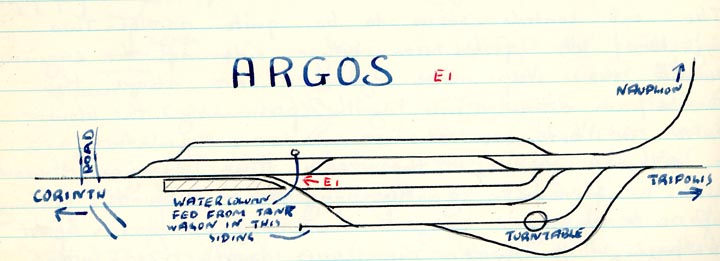 Tuesday 18 September E1-
Athens diesel railcar at Argos
We came back from Nafplion to
Athens by train today. We caught the 09.30 "Flyer" to Argos and
changed into the 10.58 (15 mins late) "fast railcar" to Athens.
The fast railcar is slower than the through railcar and is, in fact,
only faster than the steam trains. To put it mildly, the train
was crowded. We had reserved seats but had some difficulty in
claiming them because of the sheer impossibility of getting to them
because of the luggage in the gangways. It was very hot and
uncomfortable but still it was an experience well worth doing -
once. The diesel mechanical train had a two tone horn which is
similar to the British ones. The driver was quite an expert on
the horn and played some attractive sequences on it. He must
really enjoy it. We arrived at Athens at 15.15 - bang on
time. The journey along the cliffs was very exciting. At
one point we were gaily informed that this place was very dangerous
because of the sharp curve and many trains had finished up at the
bottom of the sheer cliff. Everyone took it as a great joke -
except Bob and myself. This part was a favourite ambushing area
of the Communists and I can understand why.
We went straight to the youth hostel and booked in - there was plenty of room. We met up again with Kurt who we had met at Nafplion. We went for a walk around town this evening and found the meat and fruit markets. The meat market was just closing when we went in so we didn't see a great deal. We are coming back tomorrow to buy our provisions for the journey home. All through Greece we have been glad of our Student Surety Forms which get us a reduction of 25% on SPAP (narrow gauge railway) and 50% reduction at all archaeological sites. They are valid on production of our NUS cards. Wednesday 19 September We moved our rucsacks from the hostel to the Marion Hotel roof for our last night in Athens. Went shopping this morning and had a look around the meat market with whole pigs etc. waiting to be cut up. Next to the meat market is the fish market which is very interesting with the many different types of fish that I haven't seen before. These included some, about 6" long, with pointed noses. They were also selling octopus. From the fish market we moved to the fruit market - very cheap but poorer quality 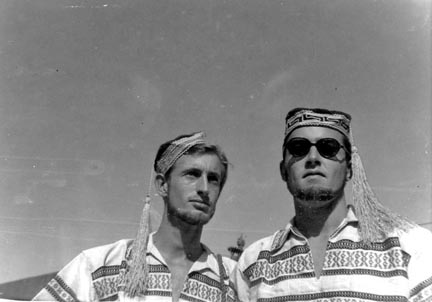 The only time I have grown a beard. Thursday 20 September First day of our long journey back to England. We embarked on the "Miaoulis" from Piraeus at 11.15 and departed at 12.00. Piraeus has the engine sheds for both standard gauge and metre gauge stock but we didn't get close enough although I saw a narrow gauge tank engine shunting trucks on the quay. We passed through the Corinth Canal at about 14.30. We took on a pilot but not a tug. There was only about ten yards to spare on either side between the ship and the vertical sides of the canal which is cut in sandstone. Arrived Patras at 20.30 (due in at 20.00). The captain made quite a mess of docking, we missd the berth completely first time and had to go full astern and have another go. We didn't stop very long and left on time at 21.00. The wind was strong most of the afternoon but luckily it dropped just before Patras. Conditions reasonable for sleeping. 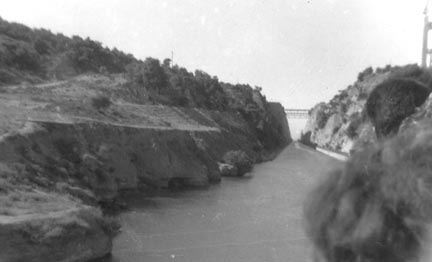 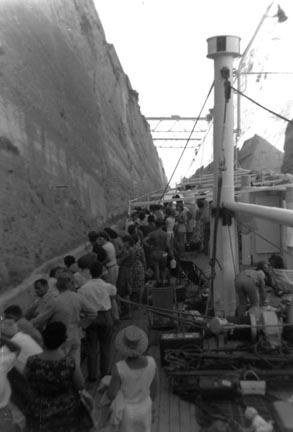 I woke just before sunrise which was obscured by clouds. We even had a few drops of rain - our first since Switzerland on the way out. We arrived at Corfu at 07.00 (1 hour late) . We didn't stay long but had to go through a fiasco of a customs examination. Left Corfu at 08.00. There were a great number of flying fish in the bay. They are blue in colour and can fly about 75 yards - their flight is quite well controlled. We passed pretty colse to the coast of the communist state of Albania and arrived at Brindisi at around 17.00. Looking across at the coast under a threatening sky I was reminded of Glazounov's "The Seasons - Autumn" which seemed to fit the mood and the weather perfectly. We went up to the station at Brindisi and spent the time there until our train left at 22.10. I saw one or two steam engines, mostly 2-6-2tender engines. We saw two storming up from Brindisi Maritime to the main station with a boat train. Our carriage has the passageway running down the middle - very uncomfortable for sleeping. Bob and I slept, or tried to sleep, in the vestibule but we were continually being walked on by people getting in. We thought we had solved this problem by tying the door handles together with string. This worked for a couple of stations but we had locked out the Guard who would give the right away then jump on to the side of the train as it left the station. As we were leaving one station there was a frantic banging on the door from the outside. I cut the string and the guard fell in on top of us. He was scared as the electric locomotive was quickly gathering speed. There was a nice draught along the foor. Saturday 22 September We arrived in Milan at 14.30 after a very boring ride. We played several hands of contract bridge to pass the time. Our train left Milan at 17.30 so we didn't have a great deal of time to spare and we didn't even leave the station. I watched the dangerous practice of stopping incoming empty stock trains by placing a man on the leading end of the train who regulates the brake valve with a stick in order to stop the train, hopefully, in the right place. If he makes a mistake there could be a collision with the stop blocks. Our seats were reserved on the French train but so that we could claim them the carriage doors and both corridor connections were all locked. We were admitted to our seats through one door only which was guarded. We played more bridge and drank Chianti to pass the time. We arranged the sleeping in the compartment so that we each took a turn in the corridor. I took the first shift and slept soundly from 22.00 until 24.00 on the floor of the corridor. Sunday 23 September Had a reasonable night's sleep on the train. Nothing much hapened on the trip to Calais. We awoke to a foggy morning - just like home. We crossed the channel on the same boat, the "Cote d'Azur". The journey up from Folkestone to London was by far the most comfortable of the whole trip. Arrived at London, Victoria at 16.00 - very exhausted indeed. Glad to get home. Sunday 30 September Spent the who;e day at Oaklands . We saw Uncle Reg's excllent movie films and slides.  |